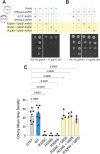A humanized yeast model reveals dominant-negative properties of neuropathy-associated alanyl-tRNA synthetase mutations
- PMID: 37010095
- PMCID: PMC10281750
- DOI: 10.1093/hmg/ddad054
A humanized yeast model reveals dominant-negative properties of neuropathy-associated alanyl-tRNA synthetase mutations
Abstract
Aminoacyl-tRNA synthetases (ARSs) are essential enzymes that ligate tRNA molecules to cognate amino acids. Heterozygosity for missense variants or small in-frame deletions in six ARS genes causes dominant axonal peripheral neuropathy. These pathogenic variants reduce enzyme activity without significantly decreasing protein levels and reside in genes encoding homo-dimeric enzymes. These observations raise the possibility that neuropathy-associated ARS variants exert a dominant-negative effect, reducing overall ARS activity below a threshold required for peripheral nerve function. To test such variants for dominant-negative properties, we developed a humanized yeast assay to co-express pathogenic human alanyl-tRNA synthetase (AARS1) mutations with wild-type human AARS1. We show that multiple loss-of-function AARS1 mutations impair yeast growth through an interaction with wild-type AARS1, but that reducing this interaction rescues yeast growth. This suggests that neuropathy-associated AARS1 variants exert a dominant-negative effect, which supports a common, loss-of-function mechanism for ARS-mediated dominant peripheral neuropathy.
© The Author(s) 2023. Published by Oxford University Press. All rights reserved. For Permissions, please email: journals.permissions@oup.com.
Conflict of interest statement
There is no conflict of interest to declare.
Figures







References
-
- Shy, M.E., Lupski, J.R., Chance, P.F., Klein, C.J. and Dyck, P.J. (2005). Hereditary Motor and Sensory Neuropathies: An Overview of Clinical, Genetic, Electrophysiologic, and Pathologic Features. In Peripheral Neuropathy: 2-Volume Set with Expert Consult Basic, pp. 1623–1658. Elsevier. 10.1016/B978-0-7216-9491-7.50072-7. - DOI
-
- Scherer, S.S., Kleopa, K.A. and Benson, M.D. (2020) Chapter 21 - Peripheral neuropathies. In Rosenberg, R.N. and Pascual, J.M. (eds), Rosenberg’s Molecular and Genetic Basis of Neurological and Psychiatric Disease, 6th edn. Cambridge, MA: Academic Press, pp. 345–375.
-
- Skre, H. (1974) Genetic and clinical aspects of Charcot-Marie-Tooth’s disease. Clin. Genet., 6, 98–118. - PubMed
-
- Braathen, G.J., Sand, J.C., Lobato, A., Høyer, H. and Russell, M.B. (2011) Genetic epidemiology of Charcot-Marie-Tooth in the general population. Eur. J. Neurol., 18, 39–48. - PubMed
-
- Laura, M., Pipis, M., Rossor, A.M. and Reilly, M.M. (2019) Charcot-Marie-Tooth disease and related disorders: an evolving landscape. Curr. Opin. Neurol., 32, 641–650. - PubMed
Publication types
MeSH terms
Substances
Grants and funding
LinkOut - more resources
Full Text Sources
Medical
Molecular Biology Databases
Research Materials

